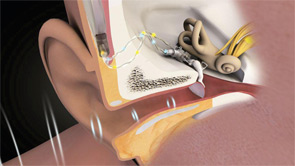Regarding the article, “Otolaryngologist Pioneers New Practice Model: Dr. Russell heralds hospitalist role as others ponder the concept’s staying power”…


Regarding the article, “Otolaryngologist Pioneers New Practice Model: Dr. Russell heralds hospitalist role as others ponder the concept’s staying power”…

For decades, otolaryngologists have been frustrated by the refusal of some patients with hearing loss to use hearing aids. Statistics on noncompliance vary, but there is general agreement that only about 20 percent to 25 percent of Americans with treatable hearing loss use hearing aids. The problem seems to be more acute for people with mild hearing loss: A consumer survey conducted by the nonprofit Better Hearing Institute in 2009 found that fewer than 10 percent of people with mild hearing loss use amplification and that even among people with moderate-to-severe hearing loss, only four in 10 use amplification.

An increasing number of physicians are venturing onto the web, and, in particular, into social media. Recently, my client Dr. M was advised by a consultant to update his practice’s website, create a Facebook page for his practice and join Twitter. The marketing consultant cautioned Dr. M that there are legal concerns for health care providers associated with the Internet and social media. While social media can be a beneficial marketing tool, it is important for physicians to have in place a specific media policy that addresses the proper ways to use this outreach both in and outside the workplace.
While recent reports show that phosphodiesterase-5 (PDE-5) inhibitors can cause sudden sensorineural hearing loss (SSHL), what is the global experience of this phenomenon? Background: SSHL has been reported after the ingestion […]
Is fixation of mandible fractures urgent? Background: There are conflicting reports on the urgency of fixing mandible fractures. While some recommend fixation within the first 72 hours, others claim that repairs […]
Have the characteristics of acute mastoiditis in children changed in the post-heptavalent pneumococcal conjugate vaccine (PCV7) era? Background: With the advent of antibiotics, the incidence of acute mastoiditis, a complication of […]
Is intraoperative neuromonitoring (IONM) of the recurrent laryngeal nerve (RLN) during thyroidectomy better than identification alone at reducing the risk of true vocal fold palsy (TVFP)? Background: TVFP is one of […]
What factors influence intraoperative and postoperative costs associated with total laryngectomy (TL) and bilateral neck dissection (BND)? Background: Given the current environment of health care reform, the ability to respond to […]
Does the duration of intubation, size of endotracheal tube or type of endotracheal tube impact the degree of laryngeal injury following intubation? Background: The incidence of laryngeal injury following intubation remains […]

A little over a year ago, I wrote an op-ed piece for ENT Today titled, “The Gender Gap in Otolaryngology: How do we make it disappear?” (February 2010). I challenged our specialty to find innovative and inclusive ways to tap into the extraordinary pool of talent found in our women otolaryngologists. And thanks to some extraordinarily enlightened leadership, we did it! Way beyond all hopes and expectations, the men and women of our specialty have paved the way for meaningful and fruitful change.